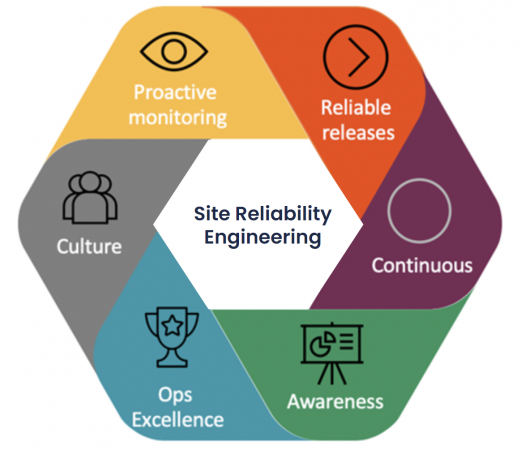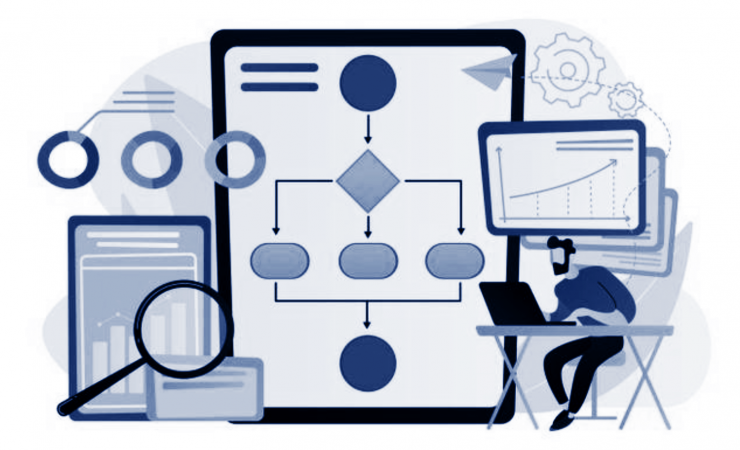Site Reliability Engineering
Part of the change-maker series
Fundamentals and Best Practices
Site Reliability Engineering (SRE) is a branch of engineering that focuses on enhancing the reliability of software services. While SRE was originally developed by Google, it has now become an industry standard and is practiced in businesses of all sizes.
The growing implementation of SRE best practices shows the efficiency of this approach in:
- guaranteeing stable uptime and accessibility,
- enhancing risk management, and
- supporting timely identification of problems.
Although Site Reliability Engineering is often leveraged by DevOps teams, the terminologies are neither similar nor exchangeable. In this article, we’ll provide a detailed overview of SRE as a methodology and its best practices. We’ll also share a few key steps to help companies establish an SRE practice across the organisation.



The Fundamentals of SRE
Traditionally, the objective of ensuring software reliability was fulfilled in diverse ways, mainly under the duty of Software Architects, DevOps, and Operations engineers. However, dedicated site reliability engineers can bring substantial benefits to the table:
- Reliable uptime and accessibility
By improving collaboration between engineers, users, and product owners, SRE professionals define and maintain uptime and availability objectives. They effectively balance feature development and accessibility using the idea of error budgets. This way, they help in setting more realistic goals for team deliverables.
- Measurement framework for consistency
Site reliability engineers define service-level indicators (SLIs) and service-level objectives (SLOs) to maintain steady operations. Teams can monitor these predefined SLIs to determine whether or not they’re meeting consistency goals.
- Improved automation
One of the biggest benefits of SRE is automation that eliminates time-consuming tasks related to production operations, especially maintenance tasks. This frees engineers to assess systems and concentrate on improving architecture and operations. At Tyme, we can help accelerate your business transformation through automation and technology engineering uplift.
- Broad understanding
SRE encourages teams to develop a comprehensive understanding of operations, modules, and systems and how these features work together. This provides a greater ability to evaluate the consequences and effects of alterations.
- Timely problem identification
Site reliability engineers are incessantly looking for bottlenecks in operations and techniques to enhance configurations. This empowers them to recognise possible complications earlier and confidently address those problems before they influence your systems.
By leveraging SRE principles, we can help increase your delivery capacity while optimising cost so that you can deliver more for less.



Top 5 SRE Best Practices
Let’s take a look at a few SRE best practices that ensure faultless system reliability.
- Analyse Changes Considering the Bigger Picture
When implementing SRE, every little change influences your entire business. So, analyse each change for the risk it brings. Keep in mind the long-term effect of the changes by looking at the bigger picture, not just how they can impact the system currently.
- Adopt a Realistic Approach
As the objective of SRE is to remove silos, it’s important to consider how a step will impact the rest of the team. When finding solutions to an issue, think about the impacts of the solution on others in the future.
At Tyme, we enable teams to transition towards a more realistic, engineering-focused approach centred around application, infrastructure, process, and automation.
- Eliminate Manual Tasks
For a company, both speed and accuracy are needed to make a system consistent. Therefore, many companies try to make their systems consistent without decelerating different processes. It’s a good SRE practice to automate wherever possible and save time you otherwise spend in unyielding manual work.
We can help reduce the amount of effort required from the standard support teams who don’t necessarily have the core Product/Platform IP or capability. By optimising the utilisation of support teams and improving the response SLAs, we empower businesses to minimise the risk of potential outages which may result in revenue leakage.



- Increase Skill Sets
You might know that skilled employees are needed to handle SRE. But do you know that a predefined skill set isn’t the only thing for effective SRE? You also have to ensure that the workforce is ready to expand their skill sets.
As SRE is a comparatively newer field, we have individuals with both development and operations experiences. Yet, you shouldn’t restrict the site reliability engineer’s role to a single background. Inspire employees to go out of their comfort zone and keep developing new skills.
- Define SLOs Like an End-User
To ensure high-quality service, you must understand what your users want and require. So, focus on defining SLOs from the viewpoint of the end-user.
For instance, focus on request latency on the client-side instead of the server-side. By concentrating on client viewpoints, you decrease the chance of your enhancement efforts going unrewarding or unobserved.
Key Steps to Establishing an SRE Practice Within an Organisation
To establish an SRE practice within your organisation, you need to build a solid SRE team. Here’s how you can go about it.
- Start With a Pilot Project
When first building an SRE team, take it as a pilot project. You don’t have to invest a huge budget to develop an extended team. Instead, understand where you want results and develop from that point.
Use iterative agile processes to build upon successes and outcomes from the pilot project to develop further. This will enable you to concentrate on matters with maximum potential value.
- Find the Right People
Building an SRE team does not mean you have to employ a new team from scratch. In fact, strong SRE teams have a blend of established subject area familiarity and fresh perspectives. So consider having a combination of current workers and new staff.
- Train and Develop Your Teams
Once you’ve recognised the right people, the next step is to train and develop them. Becoming a site reliability engineer doesn’t just mean changing the title. It is a culture modification and an alteration in mindset. Without the right basics, you’re not giving your new team the chance to prosper.
You need to provide comprehensive training to give your employees the foundational knowledge that’ll take them further through the SRE journey. That’s where Tyme can help. Together we can build a culture of continuous learning and improvement for your team.
- Define the Charter and Governance
The next step is to define the charter for your SRE team. It’ll help you determine the priorities of the employees and prevent them from getting pulled in too many directions that don’t offer business value.
For governance, always tie the SRE practices back to business value. SRE focuses on metrics and goals so the team should get governance that emphasises business metrics and developer efficiency.
How To Nurture the Organisation to Adopt SRE Practices
Once you have identified SRE best practices, start by having your team take one step in a measured timeframe. For instance:
- In the first quarter, task your team to recognise their top SLIs as part of their backlogs.
- In the second quarter, ask them to define SLOs.
- In the third quarter, ask them to report on how well they’re meeting their error budgets in a consistent manner that gives visibility to your organisation.
By following this approach, you should have quantifiable visibility into your organisation’s reliability and service health within a year.
In case you aren’t meeting your quarterly objectives, or if there’s uneven adoption across your organisation, try to figure out what’s going wrong and address it.
As your trusted partner, we can help increase the adoption rate of transformation by uplifting your existing team and enhancing capability, not just augmenting capability while we’re engaged.
Embrace SRE Principles With Tyme
At Tyme, we empower companies to navigate the complex journey of devising and implementing change, while building the capacity for the rapid adoption of emerging technologies. We enable you to drive down the overall Capex and Opex cost of platform teams through uplift across people, process, technology, and automation.
Our approach to SRE focuses on engineering a Product/Platform considering 5 core tenets:
- Quality
- Security
- Data
- Governance
- Visibility
These tenets ensure repeatability, deployability, maintainability, and reliability of the platform from inception to realisation.
We strive to deliver a solution that addresses not only your immediate needs but also ensures that it’s economically sustainable while being flexible enough to accommodate future enhancements.
Book your free discovery call to know how we can help your team implement the best SRE practices.


